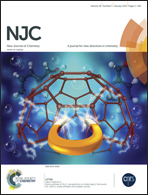Novel fluorescence resonance energy transfer optical sensors for vitamin B12 detection using thermally reduced carbon dots†
Abstract
In this paper, a novel thermally-reduced carbon dot (t-CD) based fluorescence resonance energy transfer (FRET) sensor for the determination of vitamin B12 (VB12) in aqueous solutions is reported. Carbon dots (CDs) have attracted great attention due to their excellent tunable optical properties, low cost, easy fabrication and low toxicity, which make them ideal candidates for optical sensors. Through esterification reactions, blue luminescent t-CDs were prepared by the carbonization of citric acid and thermally reduced by a thermogravimetric analyzer. After thermal reduction, the quantum yield of the t-CDs demonstrated a 5-fold increase, which makes t-CDs excellent donors in the FRET process. The t-CDs were used to detect VB12 with concentrations ranging from 1 to 12 μg ml−1 and their limit of detection (LOD) was as low as 0.1 μg ml−1. The as-synthesized t-CD based optical probing technique is demonstrated to be simple, cost-effective, sensitive and selective for the detection of biologically significant VB12.


 Please wait while we load your content...
Please wait while we load your content...